Estimated reading time 15 minutes, 46 seconds.
On Sept. 1, 1939, German troops invaded Poland. The Second World War had begun. On Sept. 10, Canada declared war on Germany.
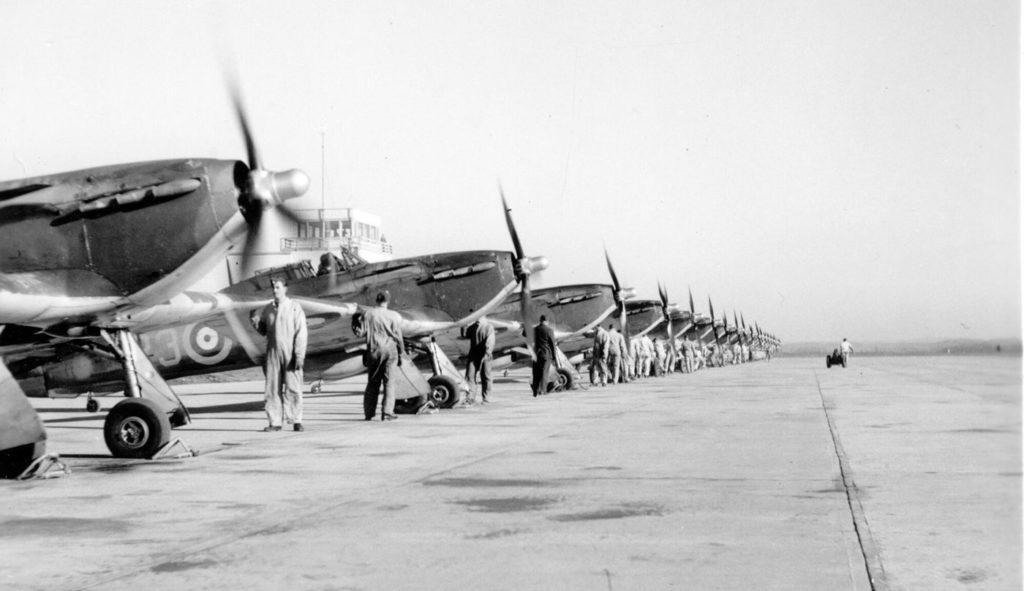
At the start of the conflict, the British government turned to Canada for its aircrew training needs. Bagotville’s Operational Training Unit (OTU) was the only Hawker Hurricane fighter training base in the country. In addition, the Ministry of Defence acknowledged the importance of protecting aluminum plants in Arvida and pulp and paper mills in Port-Alfred, Que., as well as harbours, dams, dikes and electrical generating stations located in the Saguenay–Lac-St-Jean region of the province. Thus, the Bagotville base would be home to a fighter unit tasked with protecting these facilities.
The majority of the buildings, the four aircraft hangars, and the three runways were completed by June 1942. At the end of July, No. 1 OTU was operational. At its peak, the inventory included 87 Hurricane fighters, 22 Harvard trainers, five Lysanders and three Bolingbroke target tug aircraft.

The unit of about 1,250 personnel trained an average of 50 officers and 50 sergeants (all pilots) within the nine-week course. In order to meet military fighter pilot requirements, training included combat formation, instrument, night and air combat flying, as well as shooting at stationary and moving targets. Pilots practised these manoeuvres while flying over the vast Saguenay-Lac-Saint-Jean territory.
While No. 1 OTU was preparing to undertake its mission, No. 130 Fighter Squadron landed at Bagotville on July 14, 1942. The unit was one of the nine fighter squadrons formed on the East Coast to patrol and protect industrial areas vital to the war effort. To fulfil its mission, the pilots flew Harvard trainer aircraft and P-40 Kittyhawk fighters. A year later, No. 129 (F) Squadron replaced the “Panthers” at Bagotville. Then, on Dec. 28, 1943, No. 1 OTU assumed these responsibilities.
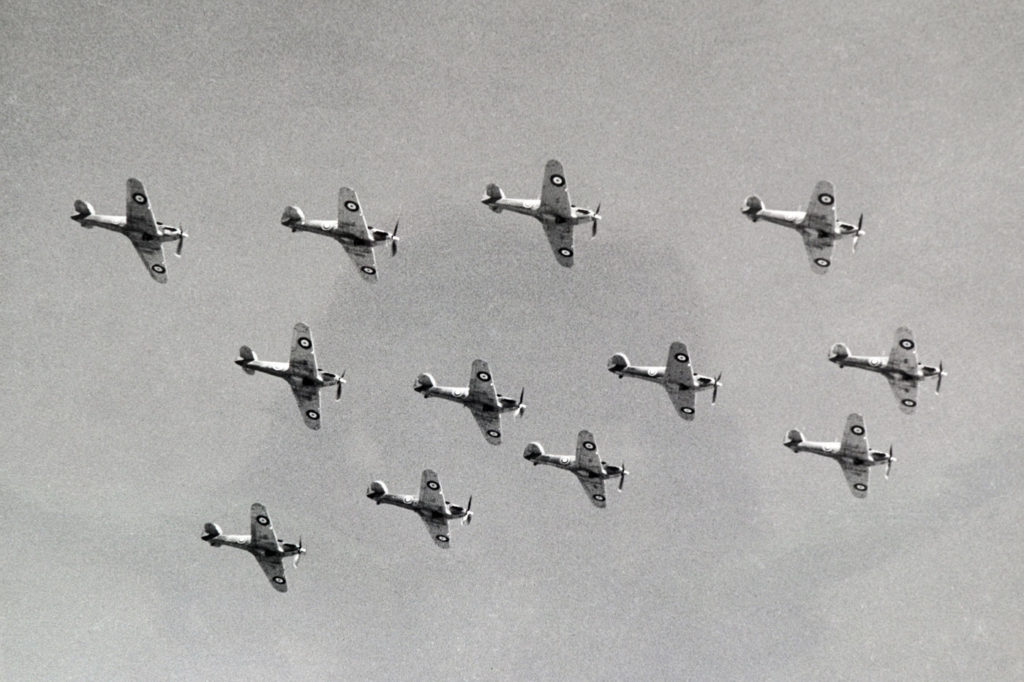
By the summer of 1944, the Allied advance in Europe could not be stopped. There was no further need for additional fighter pilots and so on Oct. 28, No. 1 OTU was relieved of its commitments. During 28 months of operations, the OTU had conducted 29 courses and graduated 940 fighter pilots. Gradually, military aircraft left Bagotville, with all buildings placed on a care and maintenance program effective Feb. 1, 1945.
The Fifties, the Cold War and NORAD
At the conclusion of the war, the world entered a new and unsettling period of peace. The reconditioning of Air Force bases and acquisition of new jet fighters to protect Canada’s airspace became a top priority for the government. With the creation of NATO in 1949, Canada committed to provide the military alliance with 12 squadrons of Canadair Sabres in Europe.
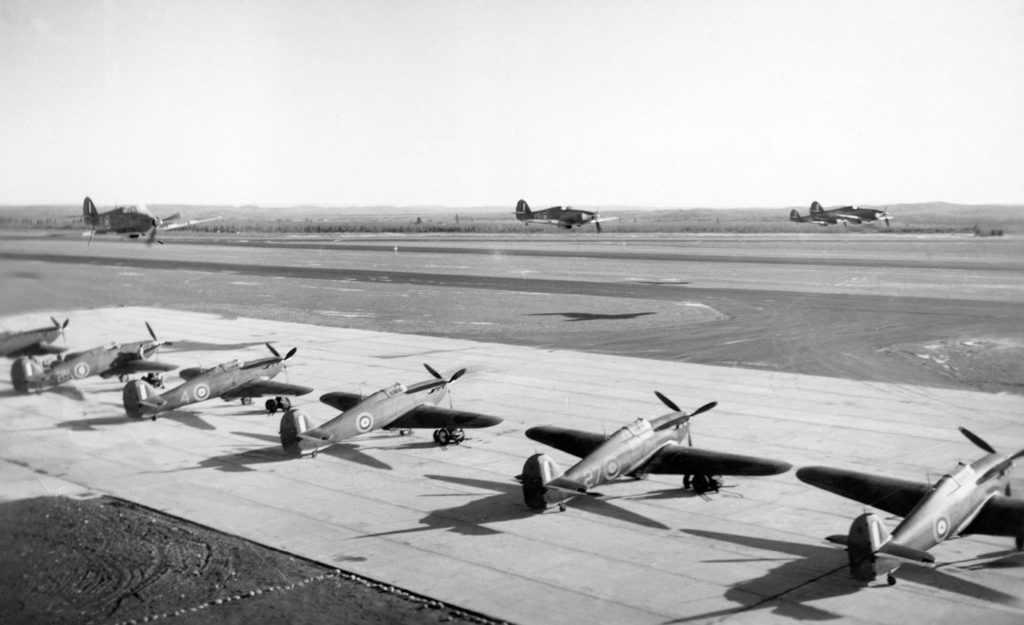
On July 1, 1951, RCAF Station Bagotville reopened. By early December of that year, No. 413 (F) Squadron was flying Sabre Mk.2 aircraft in the Saguenay skies. On Nov. 1, 1952, 414 (F) Squadron was also formed at Bagotville as a day fighter unit. In the spring of 1953, 413 (F) Squadron Sabres took off to cross the Atlantic as part of Operation Leapfrog III. On Aug. 27, 1953, 414 (F) Squadron flew to Europe as well, as part of Operation Leapfrog IV.
A few days later, No. 440 All-Weather Fighter Squadron was formed at Bagotville. It was the beginning of a new era for the base, which was now an important link to Canada’s Eastern air defence network. Equipped with Avro Canada CF-100 interceptors, the squadron was tasked with carrying out all-weather interceptions as directed by Air Defence Command (ADC), and conducting training in the same weather conditions in order to maintain the unit’s proficiency. While this was going on, the first Soviet intercontinental bombers appeared. Canada therefore found itself only a few flying hours from the USSR. In the event of an attack, the first reaction unequivocally belonged to Canadians. Consequently, a second all-weather fighter squadron was formed at Bagotville on Oct. 1, No. 432 AW(F).

The activity seen at Bagotville in 1955 accurately defined the decade between 1950 and 1960, the RCAF’s golden years. The base was not only home to the two all-weather fighter squadrons, but as well to No. 108 Communication flight. Numerous air exercises were conducted within ADC, while day and night interception missions against the highly competent B-36 and B-47 crews of the Strategic Air Command intensified.
As a result of No. 440 Squadron going to Europe in support of NATO, No. 413 AW(F) Squadron reformed at Bagotville in May 1957. During the same year, the growing perception of a Soviet long-range nuclear weapons threat prompted the American and Canadian governments to develop co-operative air defences. The North American Aerospace Defense Command (NORAD) was thus formed. Day or night, the roar of departing jets was heard as aircrews took off to practise high and low-level interceptions. RCAF Station Bagotville had an important role to play in the national defence picture. Since its units secured one flank of the all-weather fighter force in Canada, its obligation was a vital one.
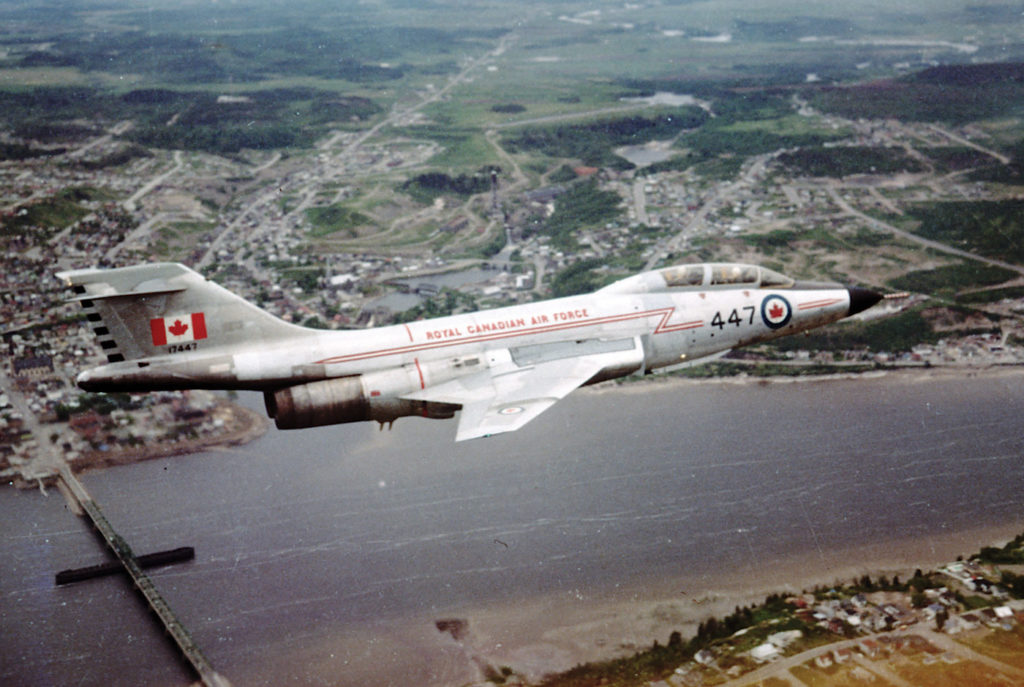
The final years of the 1950s represented the zenith of ADC and the CF-100 operations. However, the interceptor was by then obsolete and unable to adequately defend the country from any potential bomber threat. Both of Bagotville’s AW(F) squadrons were disbanded by the end of December 1961.
Protecting Canadian sovereignty
In 1961, ADC decided that No. 416 AW(F) Squadron would re-equip with the McDonnell CF-101 Voodoo interceptor and would be posted at Bagotville. The aircraft landed at the base on July 4, 1962, followed a few days later by No. 425 AW(F) Squadron Voodoos. On Oct. 1, No. 3 AW(F) OTU became the CF-101 conversion unit. Thus, with three units flying the new supersonic interceptor at the base, one could find nearly half of the Canadian fleet of CF-101s in the Saguenay region.
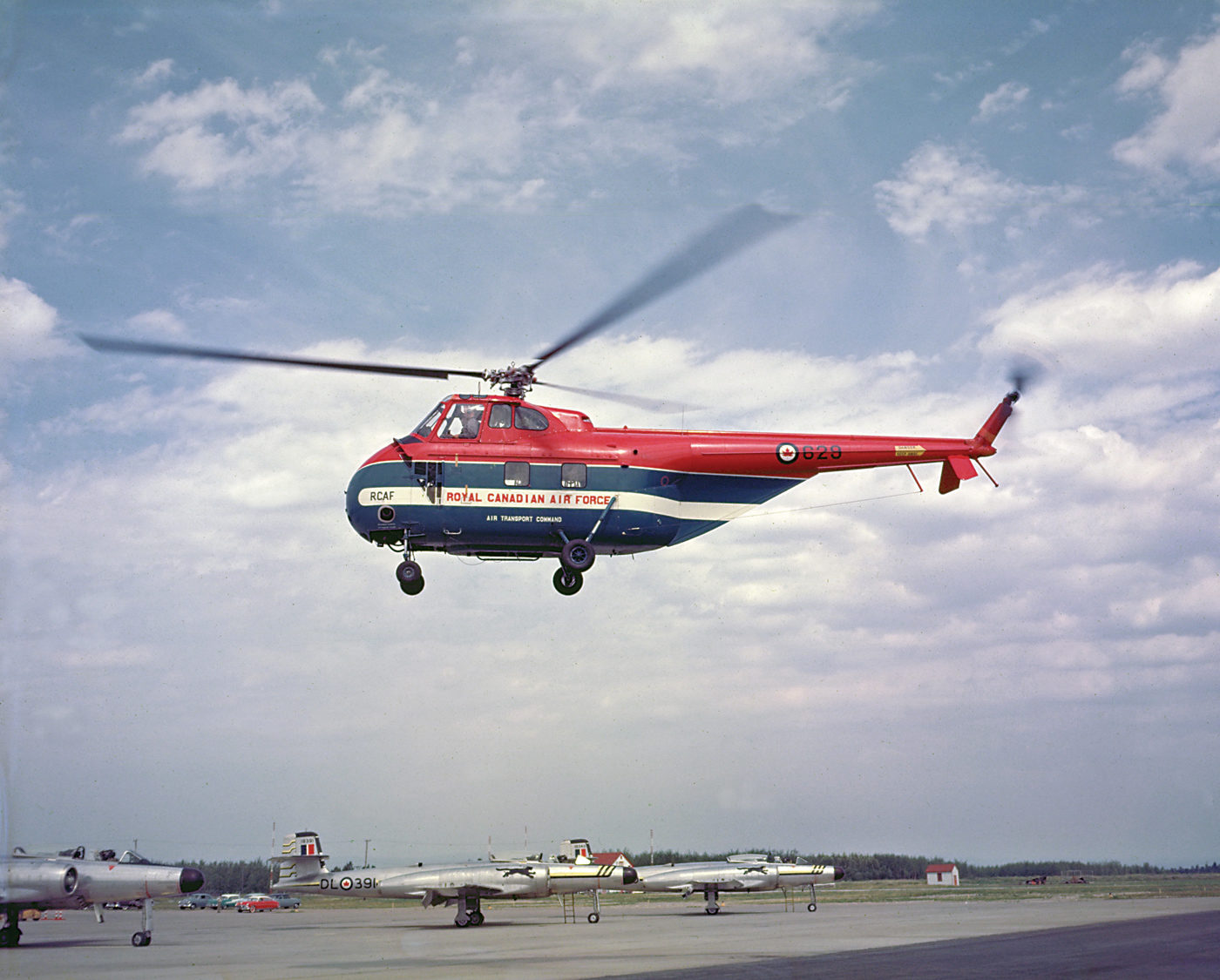
The Cuban Missile Crisis occurred a few days later. By its geographical position, Canada’s northern territory offered the shortest route between the Soviet Union and the United States. The Bagotville base was therefore in a state of continuous alert during this period. The crisis ended in late October, and Bagotville resumed its regular activities.
In early 1963, the RCAF flew the CF-101B Voodoo as a long-range strategic bomber-interceptor. The use of atomic warheads on missiles would greatly increase the jet’s operational effectiveness and as such, the military considered the aircraft most effective when utilizing the nuclear W25 warhead with the Genie rocket. Since No. 425 AW(F) Squadron could use this weapon (No. 416 Squadron had moved to Chatham, N.B.), Bagotville saw the construction of Special Ammunition Storage (SAS) and upgraded Quick Reaction Alert (QRA) facilities. In the spring of 1965, the station received the W25 nuclear warhead for the Genie rocket. The base could now be called upon to play a leading role in defending North America.
An important milestone in Bagotville’s history occurred in the fall of 1966 with the creation of the Base Rescue Flight, which would use three Piasecki H-21 helicopters; then later, three Bell CH-118 Iroquois to respond to search and rescue requests. A few months after the Canadian Forces unification, in April of 1968, No. 3 AW(F) OTU became No. 410 AW(OT) Squadron. On Aug. 15, 1968, a second French-language squadron was formed at Bagotville. This unit, No. 433 Tactical Fighter Squadron, had the task to support, among other things, the manoeuvres of ground troops. The first two Canadair CF-5 two-seater aircraft belonging to the “Porcupines” landed in Bagotville on Aug. 25, 1969.
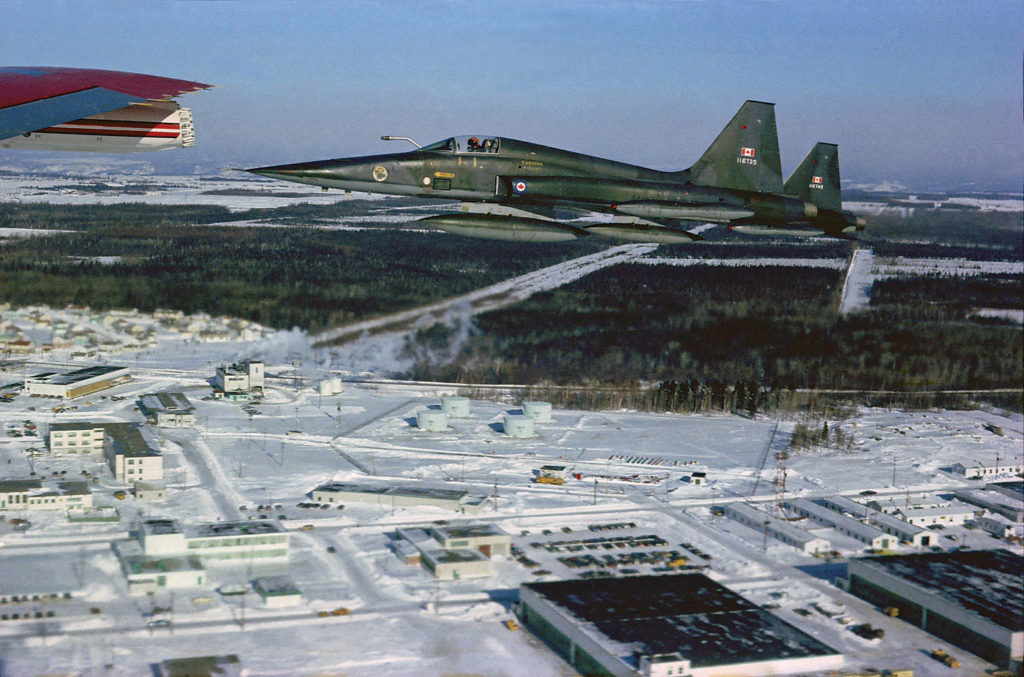
Since its arrival at Bagotville in 1962, No. 425 AW(F) Squadron had continuously maintained two armed CF-101B Voodoos inside the QRA hangars. The pilots had to be prepared to be airborne in less than five minutes following the announcement of a potential threat. The goal was to identify the intruder and to respond appropriately as soon as possible. By the mid-1970s, the interception of Russian Tu-95 Bear bombers close to the Canadian coast, en route for Cuba, was a common occurrence. The Soviets used this opportunity to test our Air Force’s reaction time, and thus were able to collect information about our defence system.
In 1975, No. 433 TFS transferred from Mobile Command to the newly created Air Command. Despite this adjustment, its mission remained the same. Notwithstanding this organizational change, exercises at home and abroad followed one another over the years at a hectic pace. Following the adoption of the Official Languages Act, bilingualism started to make real progress at Bagotville. By the beginning of the 1980s, the base conducted nearly 80 per cent of its operations and administration in French.
On April 10, 1980, the Canadian government announced the purchase of the McDonnell Douglas F/A-18 Hornet to replace the outdated aircraft in service within Air Command. [The Canadian fighters were officially designed CF-188s.] On June 15, 1984, the Voodoo performed its final flight from Bagotville’s QRA. With the withdrawal of the CF-101, the W25 nuclear warheads were returned to the United States.
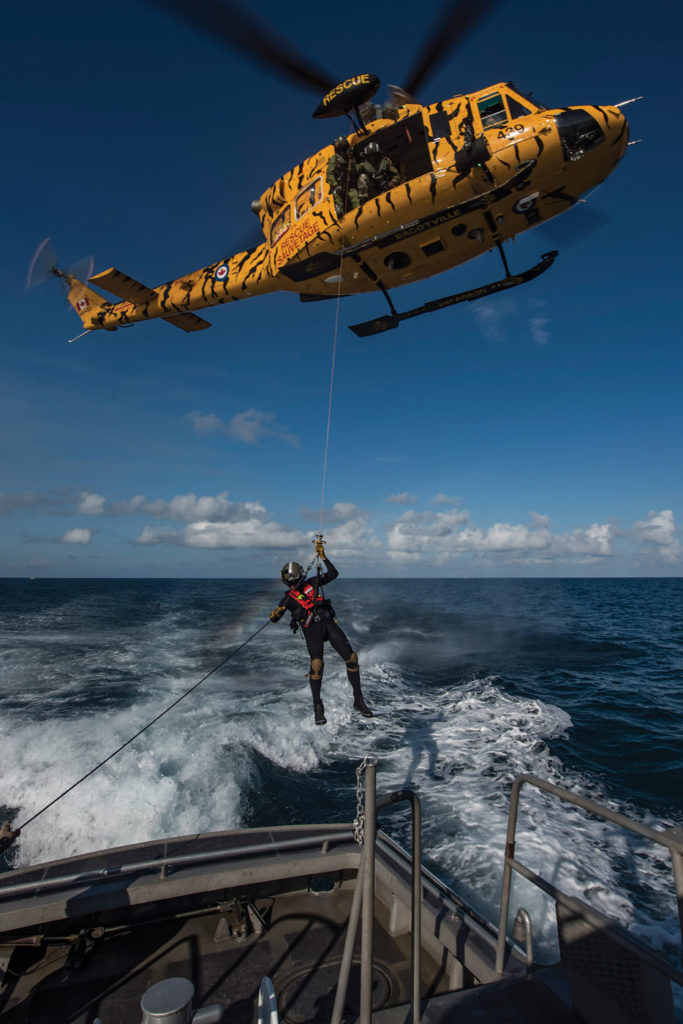
Meanwhile, for No. 433 TFS, support of ground troops remained one of the squadron’s primary responsibilities. Deployments within Canada and the United States followed one after another. Moreover, the unit continued to undergo major exercises in Norway on behalf of NATO. In early 1986, Air Command chose No. 433 to become a CF-188 squadron. On April 19, Bagotville marked the end of an era when the CF-5 retired from service within the squadron.
Air defence in the high-tech era
After an eight-month absence, No. 425 TFS returned home on April 1, 1985, proudly overflying the Saguenay. After an intensive training period, on the morning of May 31, the first two Hornets were able to maintain NORAD alert status on a 24-hour basis. Only 12 days later, Captains Matheson and Hadfield performed a “scramble” takeoff to achieve the first interception by CF-188s of two Russian Tu-95 Bear D bombers off the coast of Newfoundland.

For the “Porcupines,” Oct. 9, 1987, was a day to remember when the first CF-188 sporting the colours of No. 433 TFS landed in Bagotville. On Jan. 15, 1988, the squadron became operational once more. As the years went by, the role of the two tactical fighter squadrons has continuously adapted to changing political realities and frequent budget cutbacks. The “Alouettes” and the “Porcupines” now share the same responsibilities: the defence of Canadian sovereignty with a rapid deployment capability on behalf of NATO.
On April 1, 1993, 3 Wing relocated to Bagotville. Its responsibility was to manage all of the base’s lodger units which fell under Air Command authority. At the same time, Base Flight Unit became No. 439 Combat Support Squadron (CSS). The Base Aircraft Maintenance Engineering Organization changed to No. 3 Air Maintenance Squadron, while No. 12 Radar Squadron completed the reorganization.
From July 18 to 21, 1996, torrential rain besieged the region in a matter of only a few hours. Overflow of many rivers destroyed a large part of the Grande-Baie area in Ville de La Baie, and the Bassin area in Chicoutimi. On July 19, No. 439 CSS carried out its first rescue mission. Although most of 3 Wing’s personnel were on leave during this period, many military members returned to the base in order to help the flood victims. They set up a tent city capable of accommodating more than 1,000 refugees on base. During the first week of the rescue operation, CFB Bagotville hosted 4,189 evacuees and the kitchen served a record number of 15,000 meals! When it ended, Operation Saguenay had become one of the largest domestic rescue operations ever performed in the history of the Canadian Forces.
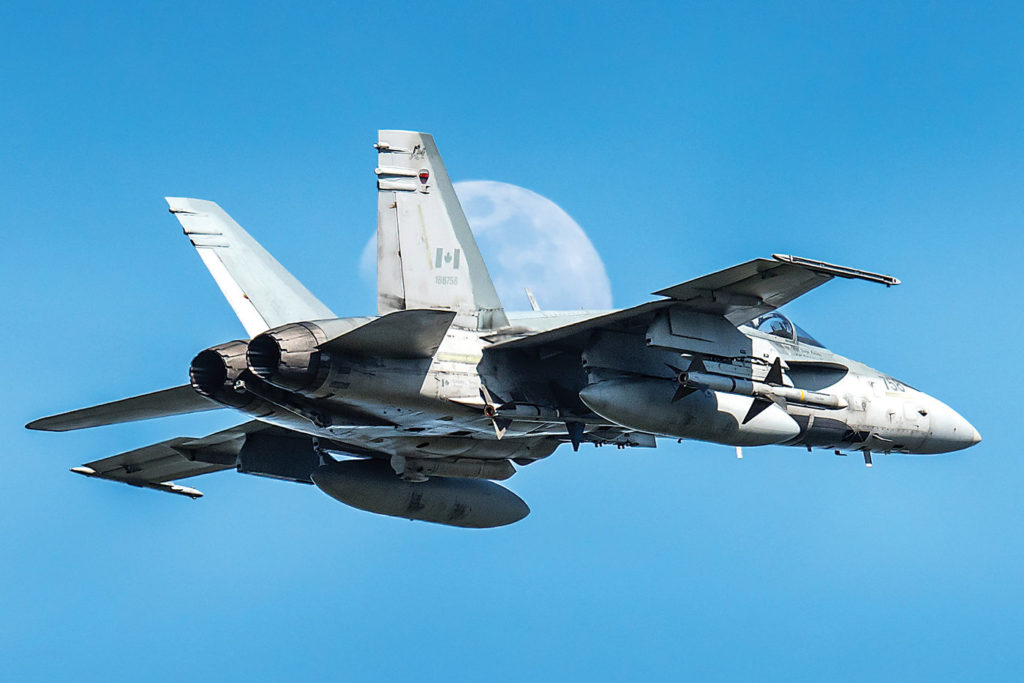
For 3 Wing and its fighter squadrons, the ability to deploy in support of NATO culminated when the situation in Kosovo (the former Yugoslavia) escalated in March 1999. The bombing campaign lasted 78 days. Bagotville’s personnel really stood out during this conflict. In all, 375 members of the Wing (about 29 per cent of the workforce) participated in the deployment to Aviano and Vicenza, Italy, for the duration of the campaign. Their important work is a legacy to peacekeeping operations in Southern Europe.
Two years later, the terrorist attacks of Sept. 11, 2001, on the World Trade Center and the Pentagon had a significant impact on Bagotville. It changed its approach to NORAD operations radically, almost overnight.
Following these events, DND gave very high priority to the setup of additional alert sites, capable of receiving armed aircraft from 3 Wing. The goal of this vision: to respond without hesitation to terrorist attacks and to assure protection of large Canadian urban centres.
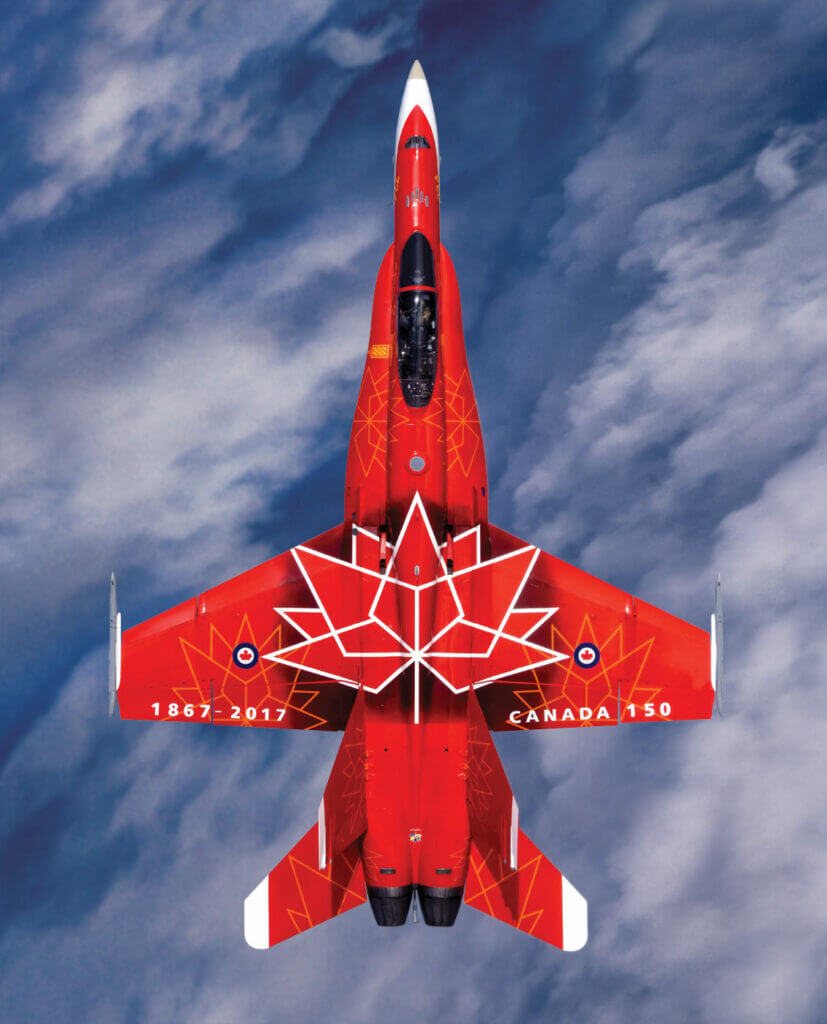
Today, 3 Wing personnel continue to support the Canadian government through the Canadian Armed Forces’ three key defence roles: to defend the country by delivering excellence at home; to defend North America (NORAD); and to contribute to international peace and security. Thus, the list of operations involving Bagotville military personnel since the beginning of the new millennium is impressive. Among others:
- Humanitarian mission to Haiti (earthquake-2010);
- Deployment to Trapani in Sicily (impose a no-fly zone over a part of Libya-2011);
- Support of the Jamaican Defence Forces (search and rescue capability-2011);
- Patrolling Iceland airspace (2013); and
- NATO Baltic Air Policing mission.
Most recently, Bagotville personnel have assisted in targeted military action in Syria as part of Operation Impact, working to dismantle and defeat the group Daesh (October 2014 to February 2016).
Finally, NORAD has acknowledged an unusual increase in incursions involving Russian aircraft near the North American Air Defence Identification Zone. On several occasions during the last few years, CF-188s from No. 425 TFS and No. 433 TFS have intercepted Russian Tu-95 Bear and Tu-160 Blackjack bombers.
True to their tradition of excellence, without compromising on the mission at hand, the base’s military will always be there to defend Canadian freedoms. This is why 3 Wing Bagotville remains today one of the most important elements of the RCAF in support of Canadian government policies, both foreign and domestic.
Marc-André Valiquette discovered aviation at a very young age. When internal ear problems prevented him from becoming a pilot, he turned to aerospace manufacturing and worked with CAE Inc. for more than 30 years. He is the author of many RCAF history books, the latest titled Bagotville – 75 Years of Air Defence.

